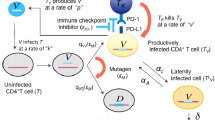Abstract
This study tried to mathematically unveil the difficulties associated with an anti-HIV therapy based on the lethal mutagenesis method; two difficulties were identified. The first difficulty of this method was that the efficacy of a mutagen must be over a certain threshold to treat HIV-1 infection, which could explain the apparent failure of the KP-1461 trial. Furthermore, we investigated the influence of the latency of HIV-1 on the treatment period and clarified that the latency increases the treatment period in a manner almost independent of the efficacy of a mutagen. This is the second difficulty associated with the lethal mutagenesis method.




Similar content being viewed by others
References
WHO (2018) Development of the global action plan on HIV drug resistance, 2017-2021. 12:11. Available from: http://www.who.int/hiv/drugresistance/hivdr-action-plan-2017-2021/en/. Accessed 5 Dec 2019
Loeb LA, Essigmann JM, Kazazi F et al (1999) Lethal mutagenesis of HIV with mutagenic nucleoside analogs. Proc Natl Acad Sci USA 96:1492–1497
Iyidogan P, Anderson KS (2014) Current perspectives on HIV-1 antiretroviral drug resistance. Viruses 6(10):4095–4139. https://doi.org/10.3390/v6104095
Mullins JI, Heath L, Hughes JP et al (2011) Mutation of HIV-1 genomes in a clinical population treated with the mutagenic nucleoside KP1461. PLoS One 6(1):e15135. https://doi.org/10.1371/journal.pone.0015135
Sedaghat AR, Siliciano RF, Wilke CO (2008) Low-level HIV-1 replication and the dynamics of the resting CD4 + T cell reservoir for HIV-1 in the setting of HAART. BMC Infect Dis 8:2. https://doi.org/10.1186/1471-2334-8-2
Callaway DS, Perelson AS (2002) HIV-1 infection and low steady state viral loads. Bull Math Biol 64(1):29–64
Mansky LM, Temin HM (1995) Lower in vivo mutation rate of human immunodeficiency virus type 1 than that predicted from the fidelity of purified reverse transcriptase. J Virol 69(8):5087–5094
Alligood KT, Sauer TD, Yorke JA (2000) Chaos: an introduction to dynamical systems. Springer, New York
Finzi D, Blankson J, Siliciano JD et al (1999) Latent infection of CD4 + T cells provides a mechanism for lifelong persistence of HIV-1, even in patients on effective combination therapy. Nat Med 5(5):512–517. https://doi.org/10.1038/8394
Guochun J, Erica AM, Philipp K et al (2015) Synergistic Reactivation of latent HIV expression by ingenol-3-angelate, PEP005, targeted NF-kB signaling in combination with JQ1 induced p-TEFb activation. PLoS Pathog 11(7):e1005066. https://doi.org/10.1371/journal.ppat.1005066
Author information
Authors and Affiliations
Corresponding author
Additional information
Publisher's Note
Springer Nature remains neutral with regard to jurisdictional claims in published maps and institutional affiliations.
About this article
Cite this article
Harada, K. A mathematical study for the development of anti-HIV-1 therapies based on the lethal mutagenesis method. Artif Life Robotics 25, 273–277 (2020). https://doi.org/10.1007/s10015-019-00578-2
Received:
Accepted:
Published:
Issue Date:
DOI: https://doi.org/10.1007/s10015-019-00578-2




